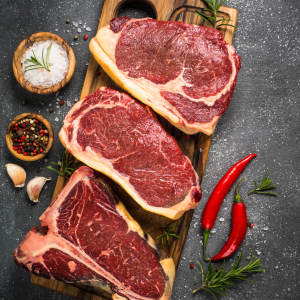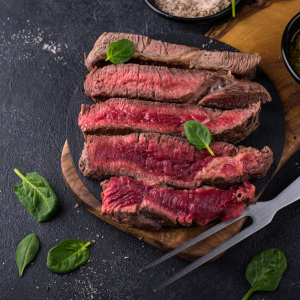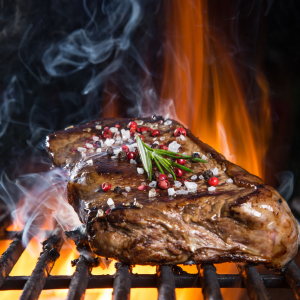If there's anything that can match the satisfaction of a well-cooked steak, it's the satisfaction of knowing you're the one who cooked it. From the perfect sear to the ideal internal temperature, cooking a steak can feel like a combination of science, art, and a little bit of magic. But like any science, any art, or any spell, it only takes a bit of practice (and a pinch of insider knowledge) to perfect it.
That’s why we’ve created this comprehensive steak temperature guide. So whether you’re a novice cook or an experienced grill master, this guide is sure to help you achieve that glorious sizzle every single time.
Choosing The Right Cut

Venturing into the captivating realm of steak temperatures involves an appreciation of the intricate diversity within the world of cuts. Each cut presents a distinct profile of flavor, tenderness, and cooking requirements that cater to a wide spectrum of culinary preferences. Let’s delve into the characteristics of some iconic steak cuts that unveil a world of options for every palate.
- Filet Mignon: Cherished for its ultra-tender, buttery texture, this lean cut is best appreciated when cooked to medium rare to maintain its luxurious silkiness.
- Ribeye: Favored for its rich marbling, which contributes to a juicy, bold flavor, the ribeye is ideal at medium to medium-well temperatures, which allow the marbling to render without losing its tenderness.
- Sirloin: With a perfect balance of tenderness and firm bite, sirloin can accommodate a wide range of preferred steak temperatures, from medium-rare to medium-well, making it versatile for diverse culinary preferences.
- T-Bone: This cut presents a culinary challenge owing to the presence of two distinctly textured steaks: the filet mignon and the strip steak. For an ideal gastronomic experience, cook it to a medium-rare to medium level, ensuring both sections reach their optimum deliciousness.
- Strip Steak: Known for its robust texture and savory flavor due to rich marbling, the strip steak is excellent at a medium temperature, which allows the fat to melt down and imbue the steak with complex flavors.
- Porterhouse: Similar to the t-bone, the porterhouse combines the tenderness of the filet mignon with the full-flavored strip steak. Cooking it at a medium temperature helps achieve a well-rounded experience, balancing the filet's tenderness and the strip's rich flavors.
The Art Of Seasoning
Before delving into the intricacies of cooking, it's paramount to recognize the fundamental role that proper seasoning plays in the steak's journey to perfection. The debate on seasoning ranges from minimalist simplicity to intricate flavor compositions, each approach with its own set of devotees. While purists advocate for the elegance of salt and pepper, others embrace the complexities of dry rubs or marinades to infuse the steak with layers of taste.
Amidst this spectrum of seasoning philosophies, salt emerges as a central protagonist in the flavor-enhancing narrative. Its innate ability to coax out the intrinsic flavors of the steak makes it a culinary powerhouse. To harness salt's potential, an essential technique lies in salting the steak at least 40 minutes prior to cooking. This pre-cooking salt application allows time for the salt to work its magic, gradually dissolving the meat's proteins and subsequently getting reabsorbed, thereby amplifying the steak's natural taste.
As you traverse the landscape of seasoning, the choices you make imbue your steak with a personality that reflects your culinary identity. Whether you opt for the simplicity of salt and pepper or the allure of more intricate flavors, seasoning unveils the art of balance in the pursuit of a harmonious taste experience.
Understanding Steak Doneness Levels

The temperature at which you cook your steak significantly influences its final taste and texture. It determines its doneness level, which is a term used to describe the degree to which a piece of steak is cooked.
Let's take a closer look at each doneness level:
- Rare (120-125°F): A rare steak sports a cool red center that's soft to the touch and offers only slight resistance when poked. With substantial internal moisture, it tends to be juicier than its more cooked counterparts.
- Medium-Rare (130-135°F): Often touted as the ideal point of doneness by many chefs, a medium-rare steak balances tenderness and juiciness with a warm, steak-red center.
- Medium (140-145°F): A medium-cooked steak gives some resistance when poked and boasts a hot center that's turned from red to pink. It retains some of its juiciness while offering a firmer texture.
- Medium-Well (150-155°F): A medium-well steak stands on the brink of losing its juiciness yet still has a hint of pink in the center.
- Well-Done (160-165°F and above): At this point, the steak is considerably firm and holds hardly any juice. The steak is entirely brown or gray throughout.
Role Of The Meat Thermometer
With a range of doneness levels, how can a home cook ensure they achieve their preferred state? Enter the meat thermometer. A meat thermometeris indispensable for anyone aiming to cook their steak to a precise level of doneness.
By inserting the thermometer into the thickest part of your steak, you can gauge its internal temperature, letting you know when your steak has reached your desired doneness level. Make sure to subtract about 5 degrees from your target temperature, as your steak will continue to cook as it rests.
Perfect Grill Marks: Understanding The Maillard Reaction
Mastering the Maillard Reaction is akin to unlocking a culinary secret that elevates steak to a new level of sensory pleasure. This intricate dance of chemistry occurs when reducing sugars and amino acids interact under the influence of heat, producing the irresistible crust that graces a perfectly cooked steak. This transformative phenomenon, often referred to as the "browning reaction," infuses the steak with a medley of complex flavors that entice the palate.
To orchestrate the Maillard Reaction with finesse, understanding its temperature range becomes imperative. This remarkable chemical interplay flourishes within the temperature window of 280-330°F (140-165°C). This optimal range is where the sugars and amino acids collaborate to form a symphony of flavors, giving birth to the savory and aromatic notes that characterize a beautifully seared steak.
Achieving that sought-after sear and those aesthetically pleasing grill marks hinges on one fundamental practice: preheating. Whether it's your grill or your pan, ensuring that it reaches the appropriate temperature before introducing the steak is paramount. A preheated surface provides the canvas upon which the Maillard Reaction unfolds its magic, allowing the steak to make a striking entrance into this flavorful performance. This simple yet essential step is the gateway to achieving not only culinary excellence but also visual appeal, as those picture-perfect grill marks become a testament to the artistry of your cooking.
Methods Of Cooking Steak

Steak, a culinary delight cherished by many, truly showcases its remarkable versatility through various cooking methods. Whether your palate craves the tender succulence of a sous vide masterpiece, the robust char of a sizzling grill, or the elegant finesse of a perfectly seared pan-cooked steak, this delectable ingredient never fails to impress.
Each cooking method requires specific tools, temperatures, and timing for a delicious meal. As you embark on this journey, this guide will help you through the art of transforming a simple cut of meat into a symphony of flavors and textures that caters to your individual taste and preference. Here, we'll outline a basic guide to some of the most common cooking methods:
Grilling
Grilling is a popular cooking method worldwide, known for its smoky flavor and grill marks. To master grilling a steak, start by learning about heat zones on the grill, particularly the two-zone fire, which allows you to control direct and indirect heat for great results.
When the steak hits the hot zone, it gets a tasty crust thanks to the Maillard reaction. To finish cooking, shift it to a cooler area for control. This way, you get a steak with a well-cooked interior and a flavorful seared exterior.
Grilling a steak combines technique, timing, and the relationship between fire and food. It's a flavorful experience that blends tradition and innovation. Whether you're a grill expert or a beginner, cooking steak on the grill is a creative culinary journey that explores taste and satisfaction. Each sizzle and sear on the grill adds to the artistry of the process.
Baking
Baking a steak in the oven involves two steps: searing the steak on the stovetop and then finishing it in a preheated oven. This method is ideal for thicker steak cuts, combining the accuracy of oven heat with the searing's flavor transformation.
When cooking thicker cuts of steak, a common and effective method is to start by searing on the stovetop and then finishing in the oven. The stovetop sear is crucial because it creates the caramelized crust through the Maillard reaction, which occurs when amino acids and sugars react under high heat, adding color and flavor to the steak.
After searing on the stovetop, the steak moves to the oven for even cooking. This method is great for thick cuts, ensuring uniform textures and temperatures. It allows you to create a delicious and tender steak, elevating it from simple to exquisite.
Pan-Searing
Pan-searing is a technique that adds a crispy crust to steaks, making them flavorful. To do it well, you need the right tool, like a cast-iron or heavy-duty pan, because it combines intense heat with the steak's tenderness.
Pan-searing is captivating because it triggers the Maillard reaction, where amino acids and sugars interact under high heat, creating a crispy exterior and a succulent interior in the steak. This process doesn't just affect the surface; it enhances the steak's taste with a mix of flavors, turning it into a culinary delight.
The choice of pan is crucial in pan-searing because it's where the culinary magic happens. A cast-iron or heavy-duty pan, known for its even cooking and heat retention, ensures the steak gets a consistent sear. The direct contact with the hot pan creates the desired crust, and its heat-holding ability ensures the inside cooks perfectly. This yields a steak with a crispy exterior, tender inside, and a blend of flavors that highlight the art of pan-searing.
Sous-Vide
Sous-vide, a popular technique for home cooking, combines science and culinary skills. It starts with vacuum sealing the steak in a pouch and cooking it in a controlled water bath. This method ensures the steak is incredibly tender and perfectly cooked to your liking.
Sous-vide cooking combines technology and culinary skills by sealing the steak in a pouch to cook it gently and evenly in its juices. The precise water bath temperature matches the desired doneness, ensuring consistent perfection throughout the steak without any guesswork.
Sous-vide stands out because it allows chefs and home cooks to experiment with various flavors and textures. After sous-vide cooking, a quick sear on a hot pan or grill adds a delicious outer crust while keeping the inside succulent. This technique doesn't just change how steak is cooked; it encourages us to rethink cooking as a whole. In sous-vide, precision is key, promising a steak experience beyond the ordinary, orchestrated by temperature and time for a symphony of flavors.
The Finishing Touches: Resting And Slicing
As your steak achieves its pinnacle of doneness, a moment of patience is called for before indulging in your culinary triumph. Letting your steak rest is a crucial interlude in the cooking saga, one that wields a transformative influence on its final texture and flavor. Resting the steak entails resisting the alluring urge to cut into it immediately after cooking. Instead, this step invites you to lay the steak gently on a cutting board, shielding it loosely with a sheet of aluminum foil.
In the process of cooking, the steak's internal juices migrate toward the surface, a result of heat-induced muscle contractions. Resting offers a sanctuary for these precious juices to embark on a journey back to their rightful places within the meat. This redistribution, facilitated by the gentle reprieve of resting, allows for a more harmonious and succulent bite with every slice. This interval can range from a few minutes for smaller cuts to upwards of ten minutes for larger steaks. This waiting period, although tantalizing, bestows its rewards in the form of heightened flavor and tenderness.
When the moment finally arrives to cut into your rested steak, the direction in which you slice becomes a key determinant of its tenderness. Cutting against the grain, or perpendicular to the muscle fibers, is a technique that's emblematic of steak prowess. By severing these fibers, you're effectively minimizing their length, thus ensuring a more tender chew. The result is an exquisite marriage of flavors and textures that showcases the marriage of culinary expertise and mindful preparation. So, as your knife meets the steak, let the wisdom of cutting against the grain elevate your dining experience to new heights of tenderness and delight.
Your Path To Steak Perfection
If you've followed us on this journey through temperatures, doneness levels, cooking methods, and seasoning advice, then congratulations, you're ready to cook the perfect steak! Remember, practice makes perfect, and each steak cooked is an opportunity to refine your skills.
So go ahead, grab that thermometer, heat up the grill (or pan, or oven, or sous-vide machine), and cook yourself the steak of your dreams. After all, nothing quite matches the simple joy of biting into a perfectly cooked, perfectly seasoned, and perfectly juicy steak, especially one that you've cooked yourself. Bon Appétit!






